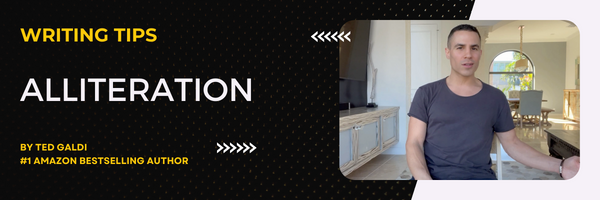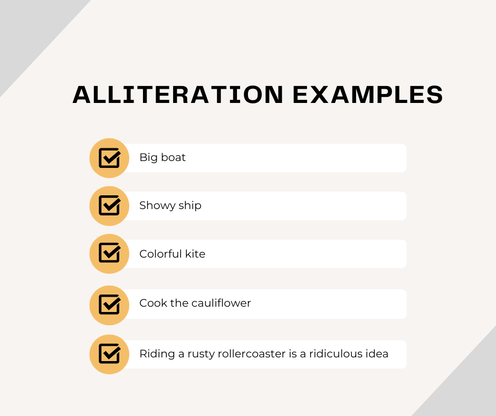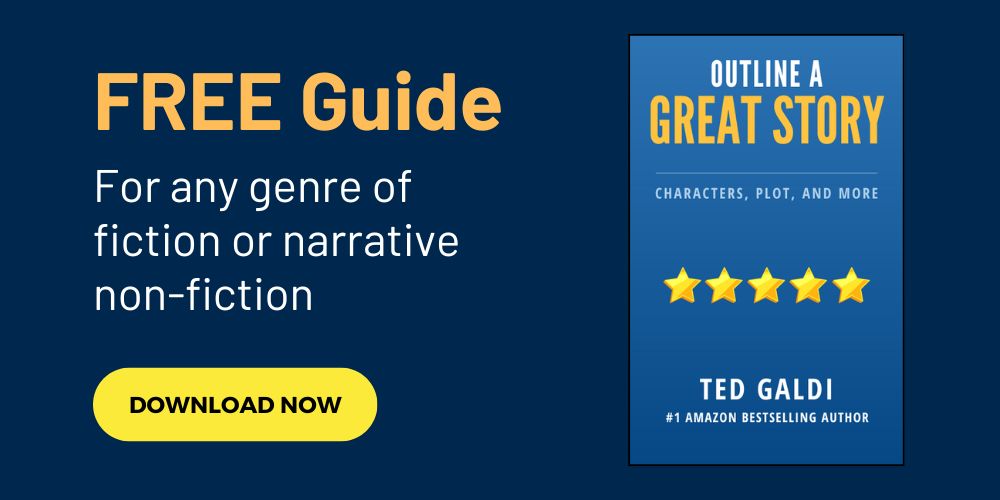Alliteration Examples [Improve Your Writing]Learn the definition of alliteration, see various alliteration examples, and pick up some tips for adding this literary device to your writing for strong effect. What is alliteration?Alliteration is the repetition of a consonant sound at the beginning of two or more close-together words, as in "big boat," with "b" the repeating sound. A repeating vowel sound doesn't form an alliteration. For example, "anticipated arrival" wouldn't qualify even though both words begin with the same "a" sound (FYI, the word pair is instead an example of another literary device, "assonance"). Alliteration examples for different soundsExamples of alliteration for "b"
Examples of alliteration for "c" (sound 1), "k," and "q"
Examples of alliteration for "ch"
Examples of alliteration for "d"
Examples of alliteration for "f" and "ph"
Examples of alliteration for "g" (sound 1)
Examples of alliteration for "h"
Examples of alliteration for "j" and "g" (sound 2)
Examples of alliteration for "l"
Examples of alliteration for "m"
Examples of alliteration for "n," "gn," and "kn"
Examples of alliteration for "p"
Examples of alliteration for "r" and "wr"
Examples of alliteration for "s" and "c" (sound 2)
Examples of alliteration for "sh"
Examples of alliteration for "t"
Examples of alliteration for "th"
Examples of alliteration for "v"
Examples of alliteration for "w"
Examples of alliteration for "y"
Examples of alliteration for "z"
Types of alliterationAlliteration's repeating sound can have one or more letters"Big boat" - which just repeats the single-lettered "b" sound - is an example of alliteration, while "showy ship" is as well, repeating a double-lettered sound, "sh." Alliteration's repeating sound can come from different letters"Colorful kite" is an alliteration because the same sound is repeated at the beginning of the words, even though that sound comes from a "c" in the first and a different letter, a "k," in the second. On the other hand, words with the same consonant at their starts don't always form an alliteration. As mentioned, alliteration is about the sound letters make, not the letters themselves. "That tornado" would not be considered an alliteration. Even though both words begin with "t," the letter is used to form different sounds in each. The words with alliteration's repeating sound don't need to be directly next to each other"Cook the cauliflower" is an example of alliteration even though the two words with the repeating sound - "cook" and "cauliflower" - aren't directly next to each other ("the" separates them). As long as the words with the repeating sound are somewhat close to each other, they form an alliteration. More than two words can have alliteration's repeating soundThough alliteration is common with pairs of words sharing a repeating sound, the sound can be repeated in a many more words as long as they're somewhat close to each other. "Riding a rusty rollercoaster is a ridiculous idea" is an example of four-word alliteration. Why is alliteration used? The human mind tries to find patterns in the world. So, when a person comes across close-together words beginning with the same sound, the mind may pay a bit closer attention to those words than others because it detects a pattern. Plus, since alliteration is based on sound, it can give writing a rhythmic, musical quality. Thus, it doesn't just draw attention to words, it draws attention to them in a pleasant way. How to use alliteration in your writingIf literary devices were food ingredients, alliteration would be sugar. Writers can add a bit of alliteration somewhere to get a reader's mind engaged in those words. However, if you dump too much sugar on something, it'll be too sweet. Somebody may take a few bites, but wouldn't want to finish. Alliteration works the same way. When it's used excessively, it draws so much attention to itself, it can pull the reader's mind away from the underlying message the words are trying to convey. If you're writing an advertising slogan with just three words, all of them starting with the same sound would probably be a good idea. However, if you're writing a chapter in a book and seventeen words in a row begin with the same sound (unironically), your reader probably won't finish your book. An example of effective alliteration in narrative writingNarrative writing is about storytelling, encompassing fiction (ex, a novel) and story-based non-fiction (ex, a biography). Narrative writing features the components dialogue and description, which can be good avenues for alliteration. Dialogue is the part of the story your characters say, while description is attributed to non-spoken parts. Let's look at this example: Howard sits on the couch and flips on the TV. His wife enters the den. She glares at him and heads upstairs. "Everything all right?" he asks. She keeps walking up the steps, without a reply. How can we enhance this segment of narrative writing with alliteration? As mentioned, you can use alliteration to draw attention to certain words. Since you should apply the device sparingly, you don't want to pick random words. You'd want to alliterate for a reason. For instance, you might want to choose words that play a strong role in a point you're making. The added attention can stress your point. In the example with Howard and his wife, her ignoring him - and him not knowing why - is the takeaway from the scene segment. Alliteration could be used to accentuate this takeaway. Here's a slightly revised version: Howard sits on the couch and flips on the TV. His wife enters the den. She glares at him and heads upstairs. "Everything all right?" he asks. She keeps walking up the steps, silent. Notice the difference? Notice the alliteration? At the very end, "steps, silent." The dash of alliteration highlights her silence, her key characteristic in the scene. Though you can use alliteration in dialogue, be careful how you do so. Good dialogue should be true to how a character would talk. Since most real-life people don't go out of their way to insert alliterations into their speech, neither should most characters. However, if a certain character in your story is grandiose, and speaking in alliterations is consistent with the character's personality, then go ahead and stay true to that. Want more writing tips?Download my FREE guide for outlining an awesome book or screenplay: You might also like my additional posts on literary devices, such as what a metaphor is and what personification is.
0 Comments
Leave a Reply. |



 RSS Feed
RSS Feed